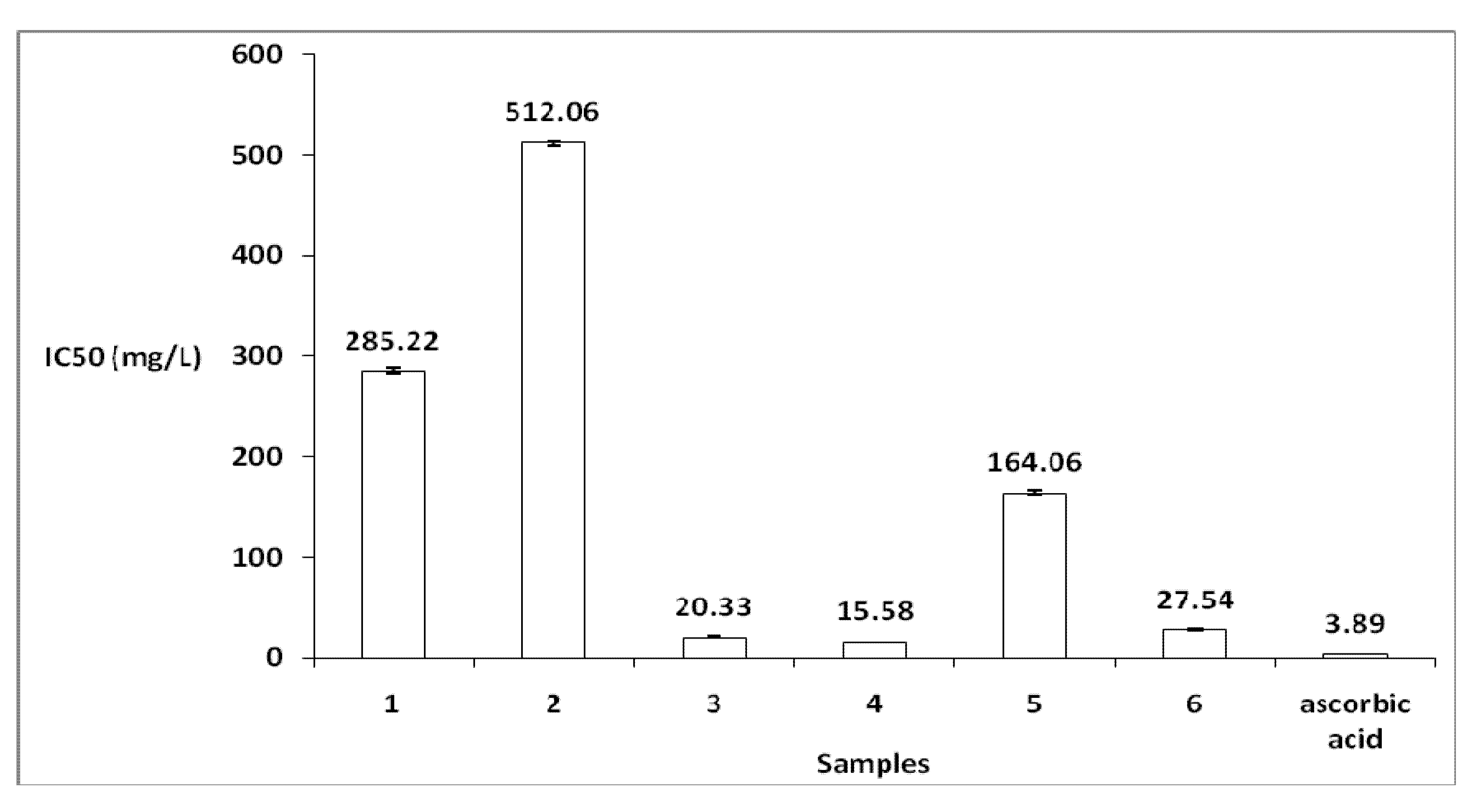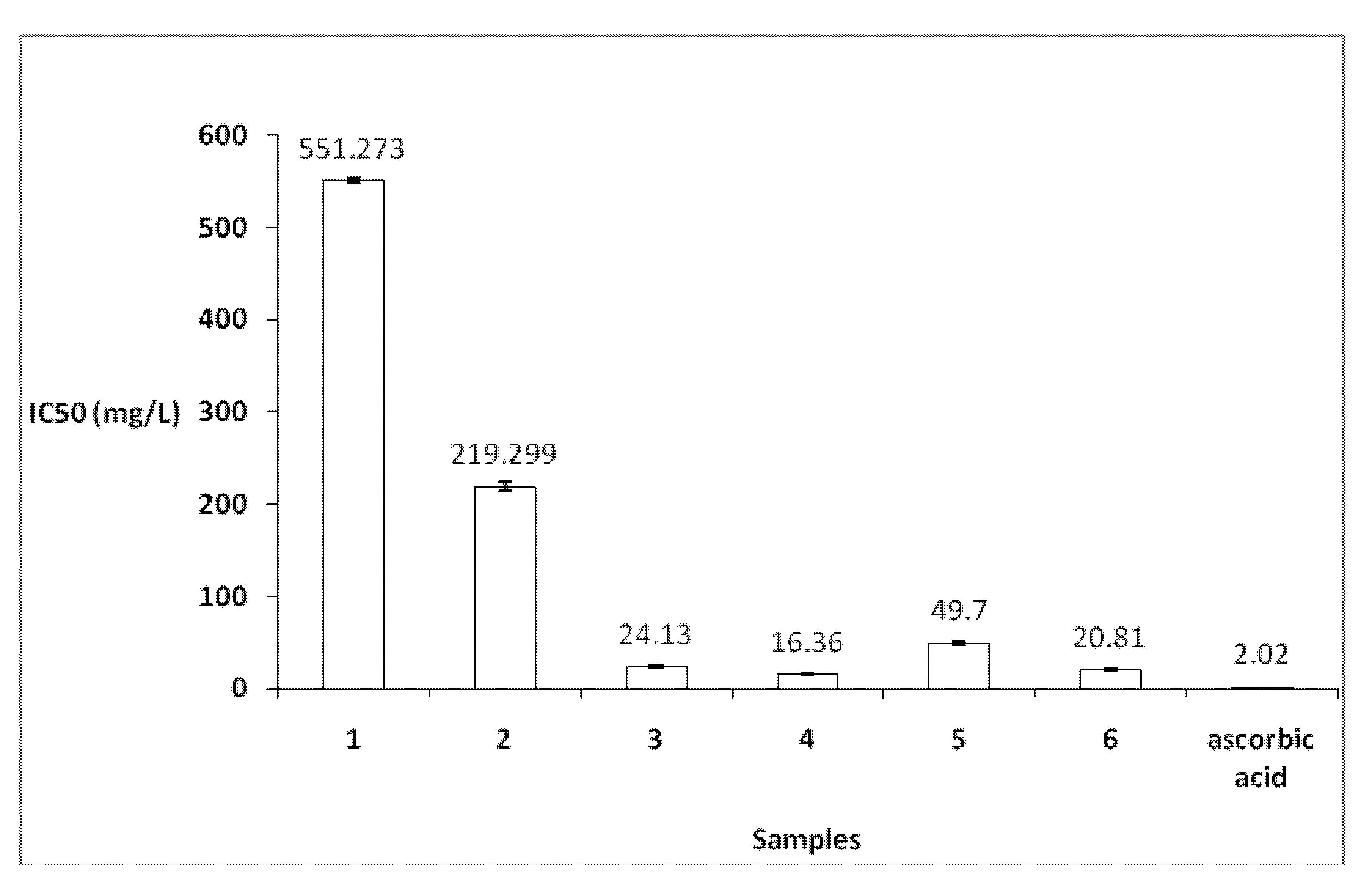Global Chemical Composition and Antioxidant and Anti-Tuberculosis Activities of Various Extracts of Globularia alypum L. (Globulariaceae) Leaves
Abstract
:1. Introduction
2. Results and Discussion
2.1. Chemical Composition
2.1.1. Extraction Yields
| Samples | Yields (%) | Polyphenols (GAE) a | Tannins (CE) a | Flavonoids (QE) a | Anthocyanins (C3GE) b | |
|---|---|---|---|---|---|---|
| Method (#1) | Methanol (75%) | 42.4 | 116.89 ± 2.80 | 1.40 ± 0.06 | 18.20 ± 0.25 | 8.17 ± 0.70 |
| Method (#2) | Petroleum ether | 15.6 | 8.50 ± 0.10 | 5.73 ± 0.06 | 0.31 ± 0.02 | nd |
| Dichloromethane | 2.4 | 41.19 ± 1.33 | 18.65 ± 0.11 | 0.34 ± 0.02 | nd | |
| Acetone | 12.9 | 109.46 ± 1.1 | 2.79 ± 0.07 | 17.08 ± 0.35 | 70.69 ± 1.53 | |
| Methanol (75%) | 37.0 | 139.95 ± 3.40 | 2.33 ± 0.06 | 19.29 ± 0.04 | 36.5 ± 2.01 | |
| Water | 1.1 | 55.10 ± 2.30 | 4.40 ± 0.06 | 1.33 ± 0.02 | 28.49 ± 3.55 | |
2.1.2. Polyphenols Content
2.1.3. Tannins Content
2.1.4. Flavonoids Content
2.1.5. Anthocyanins Content
2.2. Antioxidant Activity
2.2.1. DPPH● Assay

2.2.2. ABTS●+ Assay

2.3. Anti-Tuberculosis Activity
| CMI mg/L | IC50 mg/L (PRISM) | ||||||||
|---|---|---|---|---|---|---|---|---|---|
| Test | 1 | 2 | 3 | Average | 1 | 2 | 3 | Average | |
| Method (#1) | Methanol (75%) | >500 | >500 | >500 | >500 | nd | nd | nd | nd |
| Method (#2) | Petroleum ether | 125 | 250 | 250 | 250 ± 32 | 41 | 132 | 88 | 77 ± 11 |
| Dichloromethane | 250 | 500 | 250 | 250 ± 41 | 36 | 154 | 123 | 98 ± 13 | |
| Acetone | 250 | >500 | >500 | >500 | 135 | nd | nd | nd | |
| Methanol (75%) | >500 | >500 | >500 | >500 | nd | nd | nd | nd | |
| Water | >500 | >500 | >500 | >500 | nd | nd | nd | nd | |
2.4. Correlations
3. Experimental
3.1. Collection of Plant Material
3.2. Extraction
3.3. Determination of Total Phenolic Compounds by the Folin-Ciocalteu Method
3.4. Condensed Tannin Content
3.5. Total Flavonoids Determination
3.6. Determination of Total Anthocyanin Content
3.7. DPPH● Free Radical Scavenging Activity
3.8. ABTS●+ Radical-Scavenging Test
3.9. Anti-Tuberculosis Activity
3.10. Statistical Analysis
4. Conclusions
Acknowledgments
References and Notes
- Tura, D.; Roberts, K. Sample handling strategies for the determination of biophenols in food and plants. J. Chromatogr. A 2002, 975, 71–93. [Google Scholar] [CrossRef]
- Pietta, P.G. Flavonoids as antioxidants. J. Nat. Prod. 2000, 63, 1035–1042. [Google Scholar] [CrossRef]
- Rice Evans, C.A.; Miller, N.J.; Paganga, G. Antioxidant properties of phenolic compounds. Trends Plant Sci. 1997, 2, 152–159. [Google Scholar] [CrossRef]
- Rauha, J.P.; Remes, S.; Heinonen, M.; Hopia, A.; Kahkonen, M.; Kujala, T. Antimicrobial effects of finnish plant extracts containing flavonoids and other phenolic compounds. Int. J. Food Microbiol. 2000, 56, 3–12. [Google Scholar] [CrossRef]
- Bravo, L. yphenols, chemistry; dietary sources; metabolism; and nutritional significance. Nutr. Rev. 1998, 56, 317–333. [Google Scholar] [CrossRef]
- Middleton, E.; Kandaswami, C.; Theoharides, T.C. The effects of plant flavonoids on mammalian cells implications for inflammation; heart disease; and cancer. Pharmacol. Rev. 2000, 52, 673–751. [Google Scholar]
- World Health Organization, Implementing the Stop TB strategy: A handbook for National Tuberculosis Control Programmes; WHO Press: Geneva, Switzerland, 2008.
- World Health Organization, The world health report 2008-Primary Health Care (Now More Than Ever). Chapter I. The Challenges of a Changing World; WHO Press: Geneva, Switzerland, 2008.
- Skim, F.; Kaaya, A.; Jaouhari, J.T.; Lazrek, H.B.; Ana, M.; Elamri, H. Hypoglyceamic activity of Globularia alypum leaves in rats. Fitoterapia 1999, 70, 382–389. [Google Scholar] [CrossRef]
- Es-Safi, N.; Khlifi, S.; Lucien, K.; Albert, K.; Ducrot, P.H. Antioxidant Constituents of the Ariel Parts of Gloularia alypum Growing in Marocco. J. Nat. Prod. 2005, 68, 1293–1296. [Google Scholar] [CrossRef]
- Jouad, H.; Mhamed, M.; Mohamed, E. Hypoglycemic effect of Rubus fructicosis L. And Globularia alypum L in normal and streptozotocin-induced diabetic rats. J. Ethnopharmacol. 2002, 81, 351–356. [Google Scholar] [CrossRef]
- Elbetieha, A.; Sawsan, A.; Oran, A.; Alkofahi, H.; Darmani, A.; Raies, M. Fetotoxic potentials of Gloularia arabica and Gloularia alypum (Globulariaceae) in rats. J. Ethnopharmacol. 2000, 72, 215–219. [Google Scholar] [CrossRef]
- Fehri, B.; Tebbet, I.R.; Freiburger, B.; Karlix, J. The immunosupppressive effects of Gloularia alypum extracts. Phytother. Res. 1996, 10, 539–540. [Google Scholar] [CrossRef]
- Jouad, H.; Haloumi, M.; Rhiouani, H.; El Hilaly, J.; Eddoukes, M. thnobotanical survey of medicinal plants used for the treatment of diabetes; cardiac and renal diseases in North centre region of Morocco (Fez-Boulmane). J. Ethnopharmacol. 2001, 77, 175–182. [Google Scholar] [CrossRef]
- Jayaprakasha, G.K.; Singh, R.P.; Sakariah, K.K. Antioxidant activity of grape seed (Vitis vinifera) extracts on peroxidation models in vitro. Food Chem. 2001, 73, 285–290. [Google Scholar] [CrossRef]
- Djeridane, A.; Yousfi, M.; Nadjemi, B.; Boutassouna, D.; Stocker, P.; Vidal, N. Antioxidant activity of some Algerian medicinal plants extracts containing phenolic compounds. Food Chem. 2006, 97, 654–660. [Google Scholar] [CrossRef]
- Naik, G.H.; Priyadarsini, K.I.; Hari, M. Free radical scavenging reactions and phytochemical analysis of triphala; an ayurvedic formulation. Curr. Sci. 2006, 90, 1100–1105. [Google Scholar]
- Kishore, N.; Mishra, B.B.; Tripathi, V.; Tiwari, V.K. Alkaloids as potential antitubercular agent. Fitoterapia 2009, 80, 149–163. [Google Scholar] [CrossRef]
- Lall, N.; Meyer, J.M. Inhibition of drug-sensitive and drug-resistant stains of Mycobacterium tuberculosis by diospyrin; isolated from Euclea natalensis. J. Ethnopharmacol. 2001, 78, 213–216. [Google Scholar] [CrossRef]
- Rice Evans, C.; Miller, N.J.; Paganga, G. Structure-antioxidant activity relationship of flavonoids and phenolic acids. Free Radic. Biol. Med. 1996, 20, 933–956. [Google Scholar] [CrossRef]
- Folin, O.; Ciocalteu, V. On tyrosine and tryptophane determination in proteins. J. Biol. Chem. 1927, 27, 627–650. [Google Scholar]
- Broadhurst, R.B.; Jones, W.T. Analysis of condensed tannins using acidified vanillin. J. Sci. Food Agric. 1978, 28, 788–794. [Google Scholar] [CrossRef]
- Naczk, M.; Zadernowski, R.; Shahidi, F. Protein precipitating capacity of condensed Tanins of beach pea; canola hulls; evening primrose and faba bean. Food Chem. 2001, 73, 467–471. [Google Scholar] [CrossRef]
- Arvouet-Grand, A.; Vennat, B.; Pourrat, A.; Legret, P. Standardisation d’un extrait de propolis et identification des principaux constituants. J. Pharm. Belg. 1994, 49, 462–468. [Google Scholar]
- Cheng, G.W.; Breen, P.J. Activity of phenylalanine ammonialyase (PAL) and concentrations of anthocyanins and phenolics in developing strawberry fruit. J. Am. Soc. Hortic. Sci. 1991, 117, 946–950. [Google Scholar]
- Blois, M.S. Antioxidant determinations by the use of a stable free radical. Nature 1958, 181, 1199–1150. [Google Scholar] [CrossRef]
- Re, R.; Pellegrini, N.; Proteggente, A.; Pannala, A.; Yang, M.; Rice Evans, C. Antioxidant activity applying an improved ABTS radical cation decolorization assay. Free Radic. Biol.Med. 1999, 26, 1231–1237. [Google Scholar] [CrossRef]
- GraphPad Prism. version 5.03, 2007.
- Samples Availability: Samples of the compounds are available from the authors.
© 2011 by the authors; licensee MDPI, Basel, Switzerland. This article is an open access article distributed under the terms and conditions of the Creative Commons Attribution license ( http://creativecommons.org/licenses/by/3.0/).
Share and Cite
Khlifi, D.; Hamdi, M.; Hayouni, A.E.; Cazaux, S.; Souchard, J.P.; Couderc, F.; Bouajila, J. Global Chemical Composition and Antioxidant and Anti-Tuberculosis Activities of Various Extracts of Globularia alypum L. (Globulariaceae) Leaves. Molecules 2011, 16, 10592-10603. https://doi.org/10.3390/molecules161210592
Khlifi D, Hamdi M, Hayouni AE, Cazaux S, Souchard JP, Couderc F, Bouajila J. Global Chemical Composition and Antioxidant and Anti-Tuberculosis Activities of Various Extracts of Globularia alypum L. (Globulariaceae) Leaves. Molecules. 2011; 16(12):10592-10603. https://doi.org/10.3390/molecules161210592
Chicago/Turabian StyleKhlifi, Daycem, Moktar Hamdi, Akrem El Hayouni, Sylvie Cazaux, Jean Pierre Souchard, François Couderc, and Jalloul Bouajila. 2011. "Global Chemical Composition and Antioxidant and Anti-Tuberculosis Activities of Various Extracts of Globularia alypum L. (Globulariaceae) Leaves" Molecules 16, no. 12: 10592-10603. https://doi.org/10.3390/molecules161210592




